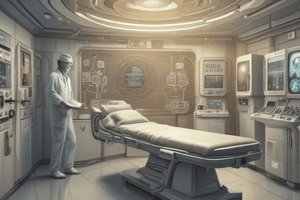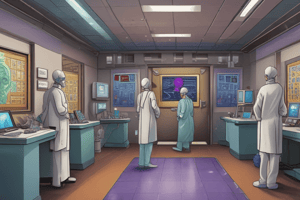Podcast
Questions and Answers
What does a FDG-PET scan detect in the brain?
What does a FDG-PET scan detect in the brain?
regions where glucose uptake is low (hypo-metabolism)
What is detected by a SPECT brain perfusion study?
What is detected by a SPECT brain perfusion study?
region of increased blood flow associated with seizure activity
What can Neuroimaging enhance in differential diagnosis in dementia?
What can Neuroimaging enhance in differential diagnosis in dementia?
- Sensitivity
- Specificity
- Both sensitivity and specificity (correct)
- None of the above
Metabolic imaging can be successfully used for the early detection of the effects of AD on the brain: regional brain damage may be _______.
Metabolic imaging can be successfully used for the early detection of the effects of AD on the brain: regional brain damage may be _______.
What can PET Brain for tumors demonstrate?
What can PET Brain for tumors demonstrate?
What is the difference between Anatomical Imaging and Functional Imaging in Nuclear Medicine?
What is the difference between Anatomical Imaging and Functional Imaging in Nuclear Medicine?
What are the roles of PET in Brain Tumors?
What are the roles of PET in Brain Tumors?
What is the principle of using radiopharmaceuticals in Nuclear Medicine?
What is the principle of using radiopharmaceuticals in Nuclear Medicine?
What information can be obtained from Metabolic Tracers used in PET for brain tumors?
What information can be obtained from Metabolic Tracers used in PET for brain tumors?
What are the strengths and limitations of amino acid tracers in PET for gliomas?
What are the strengths and limitations of amino acid tracers in PET for gliomas?
Flashcards are hidden until you start studying
Study Notes
Brain Imaging in Nuclear Medicine
-
Functional imaging provides information on processes, such as blood flow, receptor distribution, and metabolic activity, unlike anatomical imaging.
-
This differs from structural imaging, which focuses on the brain's anatomy, allowing for a more comprehensive understanding of brain function and disease.
Radiopharmaceuticals and Equipment
-
Radiopharmaceuticals are a combination of a molecule and a radioactive isotope.
-
These radiolabeled molecules bind to specific receptors or target sites within the body, allowing for the creation of detailed images of physiological processes.
-
Equipment used includes modern gamma cameras, high-resolution collimators, and pinhole collimators, which provide true optical magnification and improved resolution.
-
The use of high-resolution collimators and pinhole collimators allows for increased spatial resolution, enabling the detection of subtle changes in brain function and structure.
PET and SPECT
-
Positron Emission Tomography (PET) and Single Photon Emission Computed Tomography (SPECT) use injected tracers to visualize tumors, epilepsy, and dementia.
-
PET uses positron-emitting radiotracers, which are detected by the camera, while SPECT uses gamma-emitting radiotracers, which are detected by the camera.
-
PET has higher sensitivity and spatial resolution than SPECT.
-
This higher sensitivity and spatial resolution enable PET to detect subtle changes in brain function and structure, making it a valuable tool for diagnosing and monitoring various neurological and psychiatric conditions.
Clinical Applications
-
Brain tumors: PET differentiates between malignant and benign lesions, grades brain tumors, and guides biopsy sites.
-
This allows for more accurate diagnoses and targeted treatments, improving patient outcomes.
-
Dementia: PET and SPECT differentiate between various types of dementia, such as Alzheimer's disease, and detect deficits in brain metabolism.
-
This helps clinicians to accurately diagnose and differentiate between different types of dementia, enabling more effective treatment and management.
-
Epilepsy: PET and SPECT localize seizure origins and detect regions of increased blood flow.
-
This helps surgeons to identify the source of seizures and plan surgical interventions more effectively.
-
Brain death: Radionuclide brain death scans detect the absence of cerebral blood flow.
-
This helps clinicians to determine brain death with accuracy, enabling them to make informed decisions about treatment and end-of-life care.
PET Tracers
-
FDG (Fludeoxyglucose) measures glucose metabolism and is used for brain tumors, dementia, and epilepsy.
-
Amino acid tracers (e.g., methionine, FET) measure protein synthesis and are used for brain tumors.
-
FLT (Fluorothymidine) measures cell proliferation and is used for brain tumors.
-
The selection of the optimal PET tracer depends on the specific clinical application and the target site or process being imaged.
Dementia
-
PET and SPECT imaging can differentiate between various types of dementia, such as Alzheimer's disease, and detect deficits in brain metabolism.
-
PET scans can clarify the diagnosis and guide treatment.
-
This helps clinicians to develop personalized treatment plans and monitor treatment response.
Epilepsy
-
PET and SPECT are clinically indicated for pre-surgical localization of seizure origin.
Studying That Suits You
Use AI to generate personalized quizzes and flashcards to suit your learning preferences.




